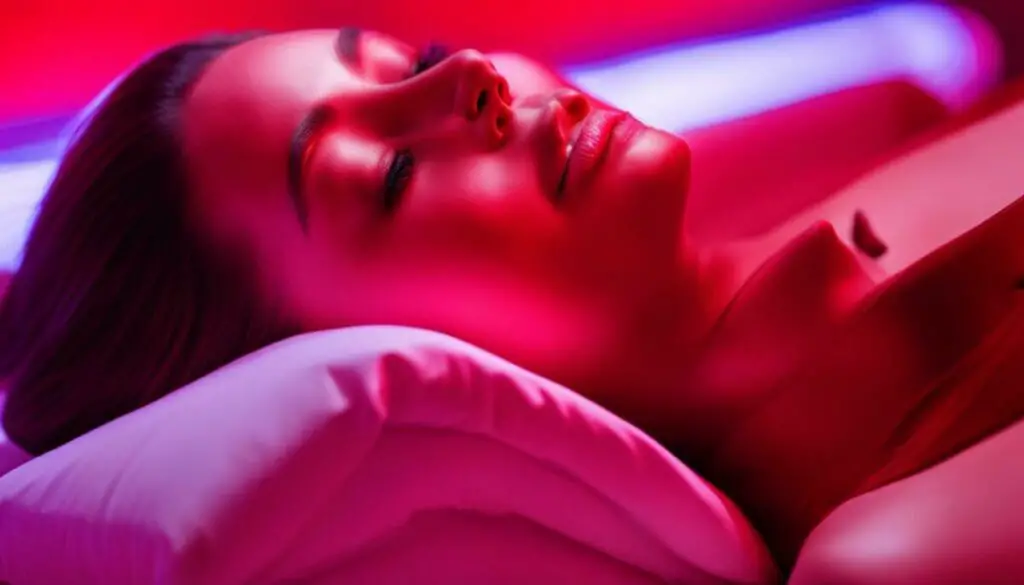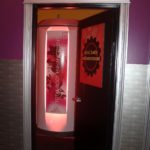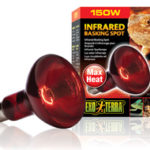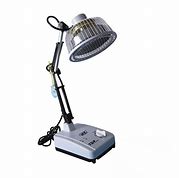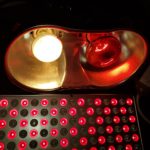Last Updated on 7 months by Francis
If you’re looking for a way to enhance your workout routine and optimize your body’s recovery, you may want to consider incorporating red light therapy. This innovative therapy uses low-level wavelengths of light to penetrate the skin and stimulate cellular rejuvenation and repair. But is it best to use red light therapy before or after a workout? And what are the specific benefits for muscle recovery and exercise performance? In this article, we’ll explore the science behind red light therapy and its potential uses for workouts.
Contents
Key Takeaways:
- Red light therapy can be a beneficial addition to your workout routine
- It can be used before or after a workout to enhance muscle recovery and exercise performance
- Red light therapy works by penetrating the skin with low-level wavelengths of light
- It can reduce inflammation, promote tissue repair, and improve endurance and muscle strength
- Incorporating red light therapy into your workout routine may require regular sessions and the use of specialized devices
What is Red Light Therapy?
If you’re looking for a natural way to improve your health and wellness, red light therapy may be just what you need. This innovative treatment involves exposing the body to low levels of red or near-infrared light, which can penetrate the skin and stimulate a range of beneficial biological processes.
Red light therapy is a non-invasive and painless way to support the body’s natural healing processes and promote overall wellness. Unlike other forms of light therapy, such as UV therapy, red light therapy does not cause damage to the skin or increase the risk of skin cancer.
So, how does red light therapy work? The light energy from red and near-infrared wavelengths penetrates the skin and is absorbed by cells in the body. These cells then use the energy to stimulate various biological processes, such as repairing damaged tissues and increasing blood flow.
There are numerous potential benefits to using red light therapy, ranging from improved skin health to enhanced exercise performance. In the next sections, we will explore some of these benefits in greater detail.
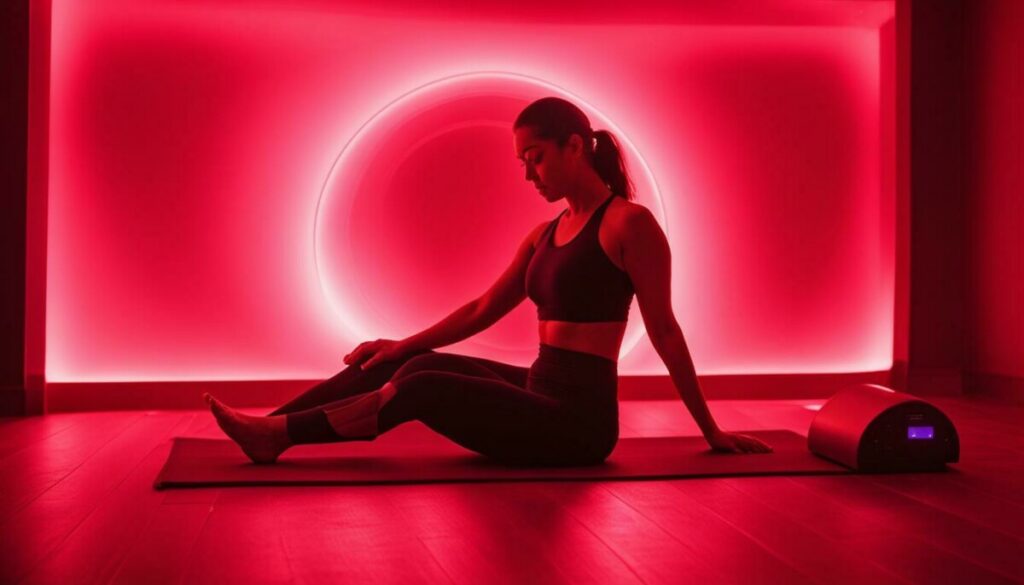
Red Light Therapy for Muscle Recovery
One of the primary benefits of red light therapy is its ability to aid in muscle recovery. Red light therapy works by stimulating the production of ATP, which is the energy source for cells. This increase in ATP production can help reduce inflammation and promote tissue repair, leading to faster recovery after intense workouts.
Studies have shown that red light therapy can also enhance blood flow to the muscles, which can aid in the delivery of oxygen and nutrients to the tissue. This increased blood flow can also help remove waste products from the muscles, which can reduce soreness and improve recovery time.
| Benefits of Red Light Therapy for Muscle Recovery |
|---|
| Reduces inflammation |
| Enhances tissue repair |
| Increases blood flow to muscles |
| Reduces muscle soreness |
| Improves overall recovery time |
Whether you are a professional athlete or a weekend warrior, incorporating red light therapy into your workout routine can help you recover faster and perform better. By using red light therapy for muscle recovery, you can reduce inflammation, enhance tissue repair, and optimize your overall recovery time.
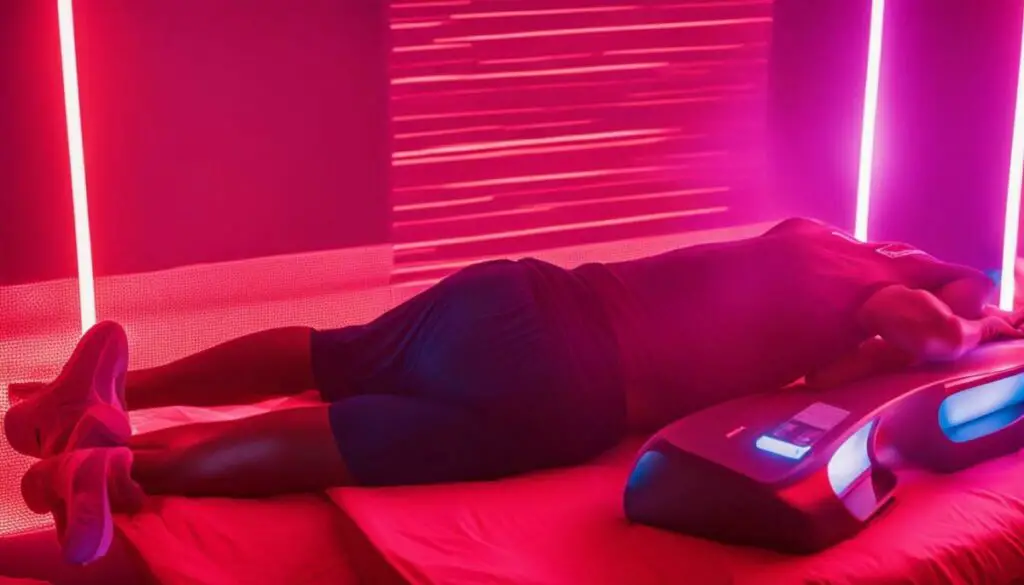
Red Light Therapy for Exercise Performance
Red light therapy can potentially enhance exercise performance in a number of ways. Studies have shown that it may improve endurance, increase muscle strength, and reduce muscle fatigue.
One study found that red light therapy improved endurance in athletes by increasing the time it took for them to reach exhaustion during a cycling test. Another study showed that red light therapy increased muscle strength in healthy young men after just two weeks of treatment.
Red light therapy may also help reduce muscle fatigue, allowing athletes to train longer and recover more quickly. A systematic review of studies on red light therapy for sports and exercise recovery found that it was effective in reducing muscle soreness and improving performance.
Overall, incorporating red light therapy into your workout routine may help you achieve better results and reach your fitness goals more quickly.

Using Red Light Therapy Before a Workout
When it comes to using red light therapy for workouts, timing is important. Many athletes and fitness enthusiasts wonder whether it’s better to use red light therapy before or after a workout. While there is no one-size-fits-all answer, some research suggests that using red light therapy before a workout can be beneficial.
One of the main benefits of using red light therapy before a workout is that it can help prepare the body for exercise. Red light therapy has been shown to increase blood flow to the muscles, which can improve oxygen and nutrient delivery and help optimize muscle activation.
Additionally, using red light therapy before a workout may enhance performance by increasing energy production in the cells. Studies have found that pre-workout use of red light therapy can lead to improved endurance and increased muscle strength.
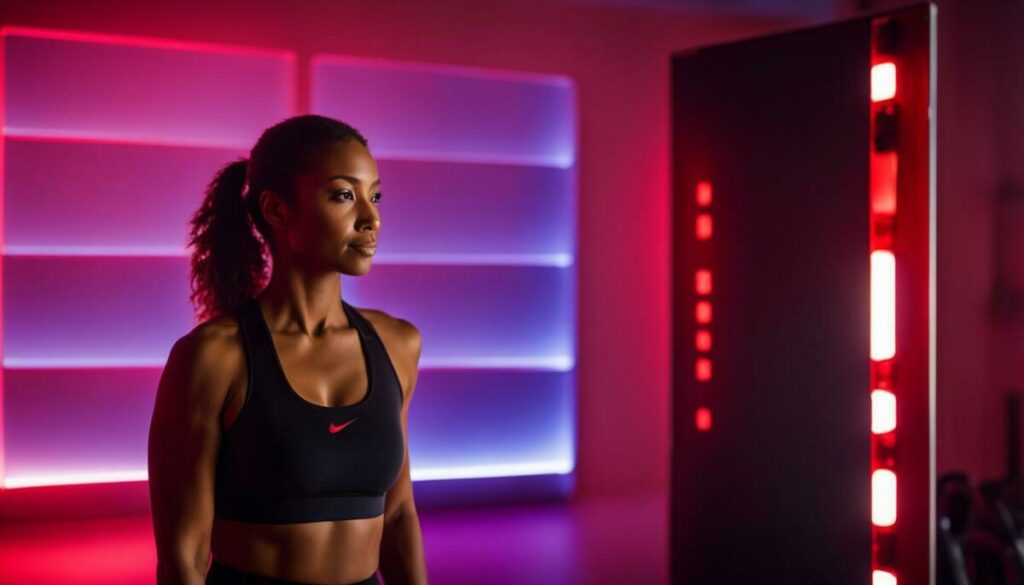
If you’re considering using red light therapy before a workout, keep in mind that it’s important to use the therapy at the right time. Ideally, you should use the therapy 30-60 minutes before your workout to allow for maximum absorption of the light by the muscles.
It’s also important to note that red light therapy is not a replacement for a proper warm-up routine. You should still perform dynamic stretches and light exercises before using the therapy to ensure that your muscles are properly warmed up and ready for exercise.
Using Red Light Therapy Before or After Your Workout
When it comes to using red light therapy for workouts, the question often arises as to whether it’s best to use it before or after exercising. The answer ultimately depends on your goals and what you hope to achieve with red light therapy.
If you’re looking to prepare your body for exercise, increase blood flow, and optimize muscle activation, using red light therapy before your workout may be the way to go.
Before a workout, red light therapy can help improve circulation, which can lead to improved muscle function and oxygen delivery. This can ultimately enhance your performance during exercise.
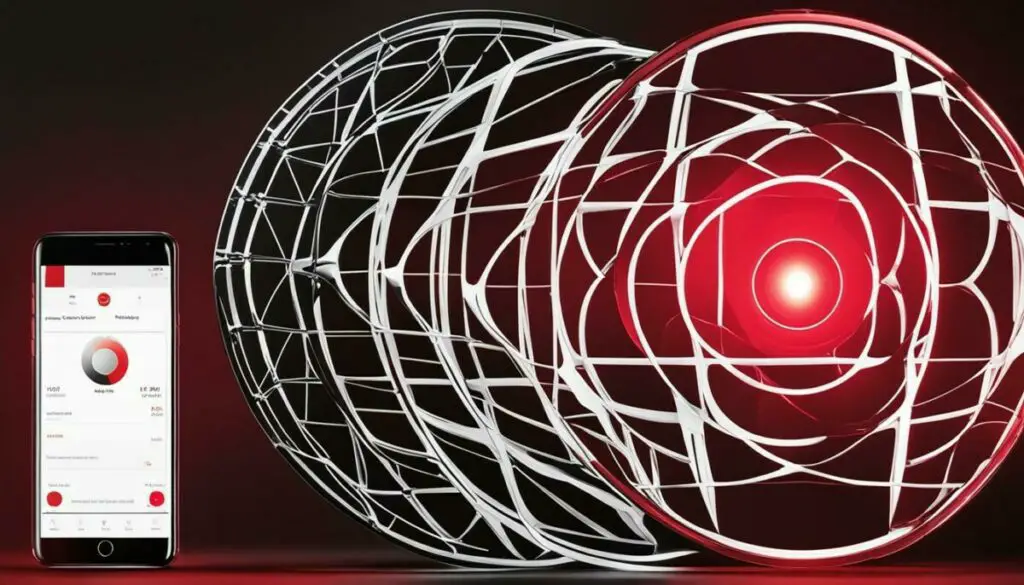
If you’re more interested in aiding your body’s recovery post-workout, reducing muscle soreness, and speeding up the healing process, using red light therapy after your workout is likely the better choice.
After a workout, red light therapy can help reduce inflammation and promote tissue repair, leading to faster recovery and less muscle soreness. It can also help mitigate any minor injuries or strains, allowing you to get back to working out more quickly.
Ultimately, the choice of whether to use red light therapy before or after your workout will depend on your specific goals and preferences. Some individuals may choose to use it both before and after their workouts for maximum benefit.
Incorporating Red Light Therapy Into Your Workout Routine
If you’re considering incorporating red light therapy into your workout routine, there are a few things to keep in mind. First, it’s important to determine the frequency and duration of your sessions. While some individuals may benefit from daily sessions, others may find that 2-3 sessions per week are sufficient. Additionally, the length of each session may vary depending on the device used and the specific area being treated.
When it comes to incorporating red light therapy into your workout routine, it’s also important to consider the different devices available for home use. Handheld devices are a convenient and affordable option for targeted treatment of specific muscle groups, while panels and full-body systems are ideal for larger areas and a more comprehensive treatment.
To get started, consider investing in a red light therapy device that aligns with your specific needs and goals. When using the device, it’s important to follow the manufacturer’s instructions and safety guidelines to ensure a safe and effective experience.
One way to incorporate red light therapy into your workout routine is to use it before or after your workout. Before a workout, red light therapy can help prepare the body for exercise by increasing blood flow and optimizing muscle activation. After a workout, it can aid in post-workout recovery, reduce muscle soreness, and speed up the healing process.
Overall, incorporating red light therapy into your workout routine can have numerous benefits for muscle recovery, exercise performance, and overall well-being. With the right device and frequency, you can optimize your workouts and achieve your fitness goals faster and more efficiently.

Red Light Therapy Benefits for Athletes
Athletes are always looking for an edge to improve their performance, and red light therapy may provide just that. The benefits of red light therapy for athletes are numerous and have been extensively studied.
Red light therapy has been shown to improve muscle recovery and reduce inflammation. One study found that red light therapy helped reduce muscle damage and inflammation following a high-intensity exercise session, leading to faster recovery times for athletes.
In addition to faster recovery times, red light therapy may also enhance exercise performance. Another study found that endurance athletes who used red light therapy prior to a cycling competition experienced less muscle fatigue and improved performance compared to those who did not use red light therapy.
Red light therapy may also help prevent injuries in athletes. By promoting tissue repair and reducing inflammation, red light therapy can help athletes recover from minor injuries before they become more serious.
Overall, incorporating red light therapy into an athlete’s training regimen can lead to faster recovery times, improved performance, and injury prevention.

Potential Side Effects and Safety Considerations
While red light therapy is generally considered safe, it is important to take proper precautions and follow guidelines to avoid any potential side effects.
Firstly, it is important to use red light therapy devices as directed, and avoid overuse or prolonged exposure. While red light therapy is non-invasive and has no known side effects, excessive use can potentially lead to skin irritation or dehydration.
When using red light therapy before or after a workout, it is important to ensure that the skin is clean and free of any lotions, oils, or other products that may interfere with the therapy. Failure to do so may reduce the effectiveness of the therapy.
Additionally, individuals with a history of photosensitivity, or those who are taking medication that increases sensitivity to light, should consult with a healthcare professional before using red light therapy.
It is also important to note that red light therapy is not a replacement for medical treatment. While it may provide benefits for workout recovery and performance, it should not be used as a substitute for professional medical advice or treatment.
Overall, when used correctly, red light therapy is a safe and effective method for enhancing workout recovery and performance.
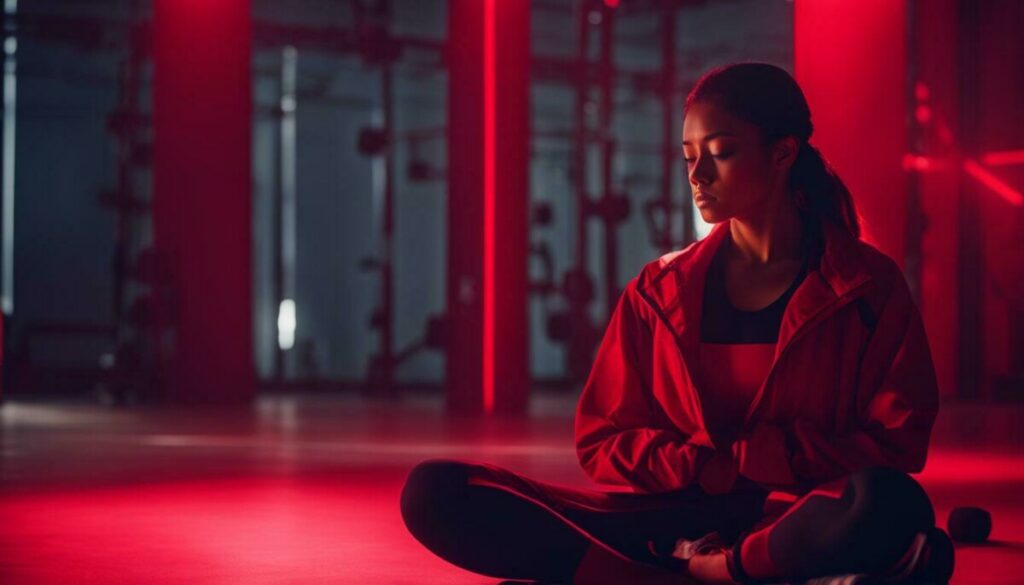
Research and Evidence on Red Light Therapy
While red light therapy is a relatively new technology, there is a growing body of research supporting its benefits for workout recovery and performance.
One study published in the Journal of Strength and Conditioning Research found that red light therapy improved muscular endurance and increased the time to exhaustion during high-intensity exercises. Another study showed that red light therapy reduced muscle fatigue and soreness, allowing for quicker recovery after exercise.
But the benefits of red light therapy aren’t just limited to athletes. A study published in the Journal of Clinical and Aesthetic Dermatology found that red light therapy can improve skin health, stimulate collagen production, and reduce inflammation.
Overall, the research on red light therapy is promising, with numerous studies demonstrating its potential benefits for muscle recovery, exercise performance, and overall health and wellness.
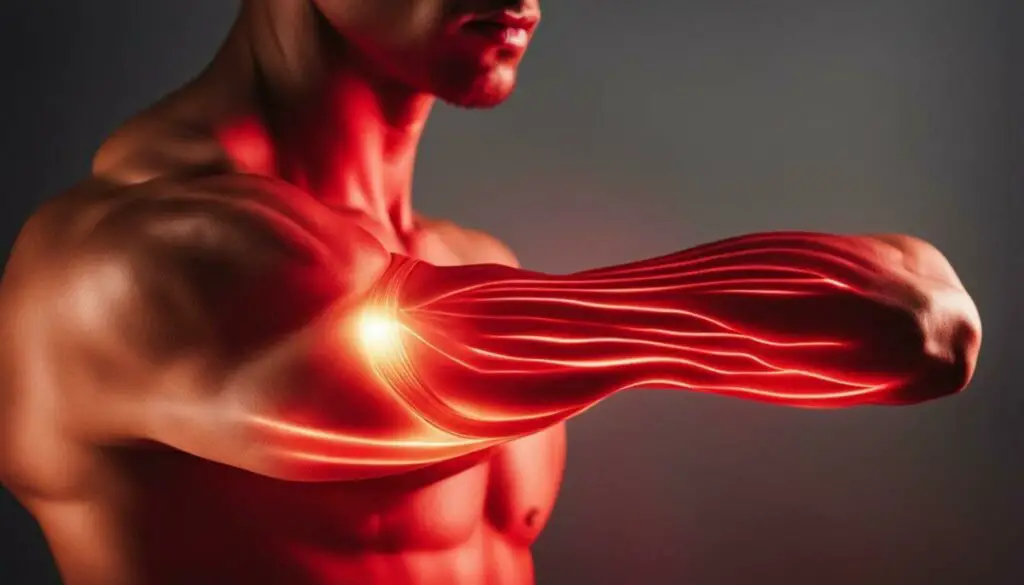
Red Light Therapy Devices and Options
If you’re considering incorporating red light therapy into your workout routine, there are a variety of devices and options to choose from. Handheld devices are compact and portable, making them a convenient choice for targeted areas. Panels are larger and can cover a wider surface area, while full-body systems provide a more comprehensive treatment.
One popular option is the Joovv, which offers a range of devices for at-home use. Their Solo model is a handheld device featuring medical-grade LEDs and a rechargeable battery for easy use on-the-go. The Joovv Go is a portable, battery-powered panel that can be used for targeted treatment or full-body use. The Joovv Max is a larger, wall-mounted panel designed for full-body therapy.
Another option is the Red Light Rising full-body system, which uses powerful LEDs to deliver a full-body treatment in just a few minutes per day.
When choosing a device, consider the size and convenience you need for your lifestyle, as well as the intensity and quality of the LEDs. Keep in mind that consistent use is key for seeing results, so choose a device that is easy and enjoyable to use regularly.
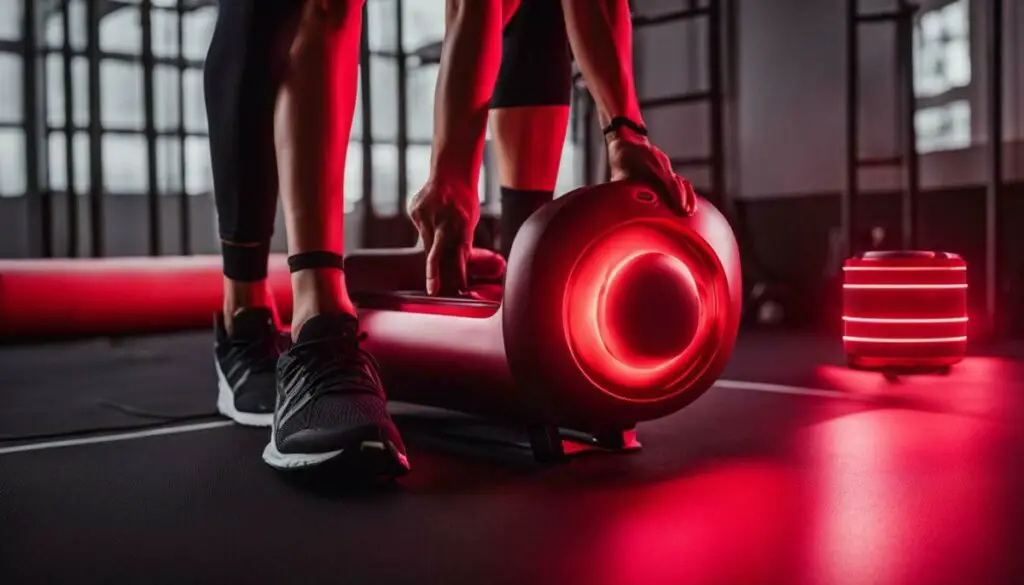
Red Light Therapy vs Other Recovery Modalities
While red light therapy has shown promising results for workout recovery and performance enhancement, it’s important to consider how it stacks up against other popular recovery modalities. Here’s a closer look at some of the most commonly used techniques:
| Recovery Modality | Benefits | Drawbacks |
|---|---|---|
| Ice Baths | – Reduces inflammation – Eases muscle soreness |
– Can be uncomfortable – May decrease muscle activation |
| Compression Therapy | – Increases blood flow – Decreases muscle soreness |
– Requires specialized equipment – Can be time-consuming |
| Massage | – Relaxes muscles – Enhances blood flow |
– Can be expensive – Requires a trained professional |
While these techniques can be effective on their own, many athletes and fitness enthusiasts choose to combine them with red light therapy for even greater benefits. For example, using red light therapy after an ice bath or a massage can help enhance the effects of these modalities and speed up recovery time.
Ultimately, the best recovery modality for you will depend on your individual needs and preferences. Experimenting with different techniques and finding what works best for you can help maximize your workout and improve your overall fitness.

User Experiences and Testimonials
Many individuals have incorporated red light therapy into their workout routine and have seen remarkable results. One user shared, “After using red light therapy before my workouts, I have noticed a significant increase in energy and performance. My muscles also feel less fatigued, allowing me to push myself harder.”
Another user reported, “I have struggled with muscle soreness and stiffness after exercise, but incorporating red light therapy into my routine has helped tremendously. I feel more relaxed and less achy after workouts.”
Overall, users have praised red light therapy for its ability to enhance muscle recovery and improve exercise performance. By incorporating red light therapy into your workout routine, you can experience these benefits for yourself.

These testimonials support the efficacy of red light therapy and further demonstrate its potential benefits for workout recovery and performance. It is essential to remember that individual experiences may vary, and it is crucial to consult with a healthcare professional before starting any new regimen.
Professional Recommendations and Expert Opinions
Red light therapy has gained popularity in recent years due to its potential benefits for workout recovery and performance. Many athletes, trainers, and healthcare professionals have shared their experiences and insights on incorporating red light therapy into their routines.
According to Dr. Michael Hamblin, a researcher at Harvard Medical School, “Red light therapy can help with muscle recovery and reduce muscle soreness, allowing for more frequent high-intensity workouts.”
NFL quarterback Tom Brady has also spoken about his use of red light therapy, stating that “It helps me recover faster from workouts and gets me ready for the next one.”
Athletic trainer and strength coach Brandon McDaniel recommends using red light therapy before and after workouts to “maximize performance and speed up recovery.”
Overall, many experts in the fitness and healthcare industries endorse the use of red light therapy as a safe and effective way to support workout recovery and performance. Incorporating red light therapy into your workout routine may help optimize your training and achieve your fitness goals.
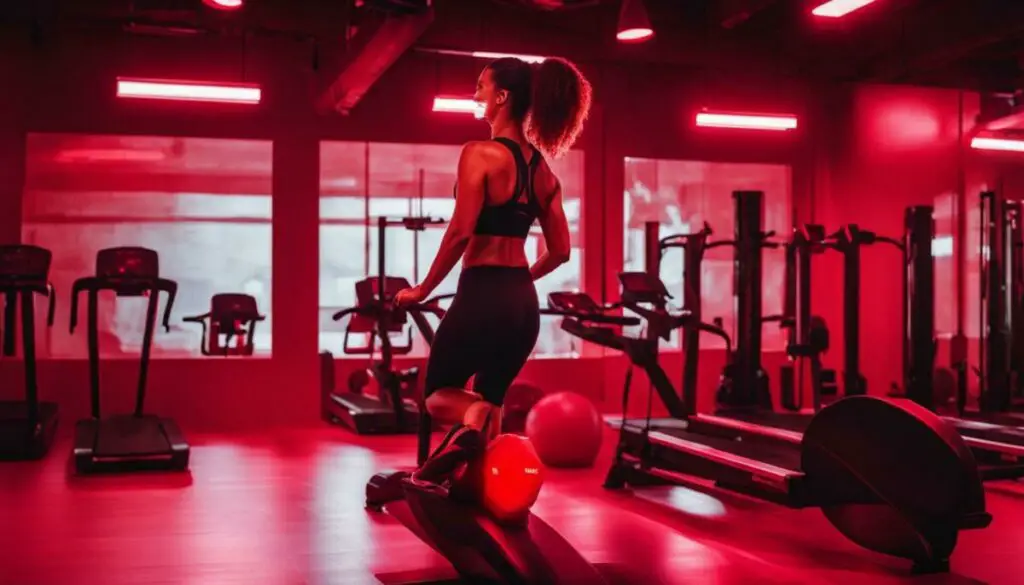
Conclusion
Incorporating red light therapy into your workout routine can have a significant impact on your muscle recovery and exercise performance. While both pre and post-workout use of red light therapy have their benefits, the best approach may depend on individual goals and preferences.
Research has shown that red light therapy can help reduce inflammation, promote tissue repair, and enhance overall recovery after intense workouts. Additionally, it may improve endurance, increase muscle strength, and reduce muscle fatigue.
To incorporate red light therapy into your routine, consider investing in a handheld device, panel, or full-body system. Aim for a frequency of 2-3 sessions per week, lasting anywhere from 5-30 minutes.
It’s important to note that while red light therapy is generally considered safe, there are some potential side effects and safety considerations to keep in mind. Always follow proper usage guidelines and consult with a healthcare professional if you have any concerns.
Overall, incorporating red light therapy into your workout routine may be a game-changer for athletes and fitness enthusiasts alike. Give it a try before or after your next workout and see the benefits for yourself.
FAQ
Can red light therapy be used before or after a workout?
Yes, red light therapy can be used both before and after a workout to enhance its benefits. It can help prepare the body for exercise and promote muscle recovery.
How does red light therapy work?
Red light therapy works by stimulating the mitochondria in our cells, which then leads to increased energy production and a range of positive effects on the body. It promotes tissue repair, reduces inflammation, and enhances overall cellular function.
What are the benefits of red light therapy for muscle recovery?
Red light therapy can aid in muscle recovery by reducing inflammation, promoting tissue repair, and improving circulation. It can help speed up the healing process after intense workouts and reduce muscle soreness.
Can red light therapy improve exercise performance?
Yes, red light therapy has the potential to enhance exercise performance. It has been shown to improve endurance, increase muscle strength, and reduce muscle fatigue, thereby enhancing overall athletic performance.
Should red light therapy be used before or after a workout?
The timing of red light therapy can depend on individual preferences and goals. Using it before a workout can help prepare the body and optimize muscle activation, while using it after a workout can aid in recovery and reduce muscle soreness.
How can red light therapy be incorporated into a workout routine?
Incorporating red light therapy into a workout routine can be done by using it before or after exercise sessions. The frequency and duration of sessions can vary depending on individual needs. There are different devices available for home use, including handheld devices, panels, and full-body systems.
What are the benefits of red light therapy for athletes?
Red light therapy offers several benefits for athletes, including injury prevention, faster recovery from intense training, and enhanced performance. It can help athletes optimize their training and achieve their fitness goals more effectively.
Are there any side effects or safety considerations associated with red light therapy?
Red light therapy is generally considered safe and non-invasive, with minimal side effects. However, it is important to follow usage guidelines and precautions to ensure a safe and effective experience.
Is there scientific research supporting the benefits of red light therapy?
Yes, there is scientific research and evidence supporting the benefits of red light therapy for various health conditions, including muscle recovery, exercise performance, and athletic performance. Several studies have demonstrated its positive effects on the body.
What are the different red light therapy devices and options available?
There are various red light therapy devices available, including handheld devices, panels, and full-body systems. Each option has its own pros and cons, and the choice depends on individual preferences and needs.
How does red light therapy compare to other recovery modalities?
Red light therapy offers unique benefits and can be used in conjunction with other popular recovery modalities such as ice baths, compression therapy, and massage. Combining different techniques can potentially enhance the overall recovery and performance benefits.
What do users say about their experiences with red light therapy?
Users have reported positive experiences with red light therapy, noting its benefits for workout recovery and performance. Many have seen improvements in muscle soreness, recovery time, and overall physical well-being.
What do professionals and experts say about red light therapy?
Professionals and experts, including athletes, trainers, and healthcare professionals, have recommended and praised the benefits of red light therapy for workout recovery and performance. Their insights provide valuable perspectives on its effectiveness.



